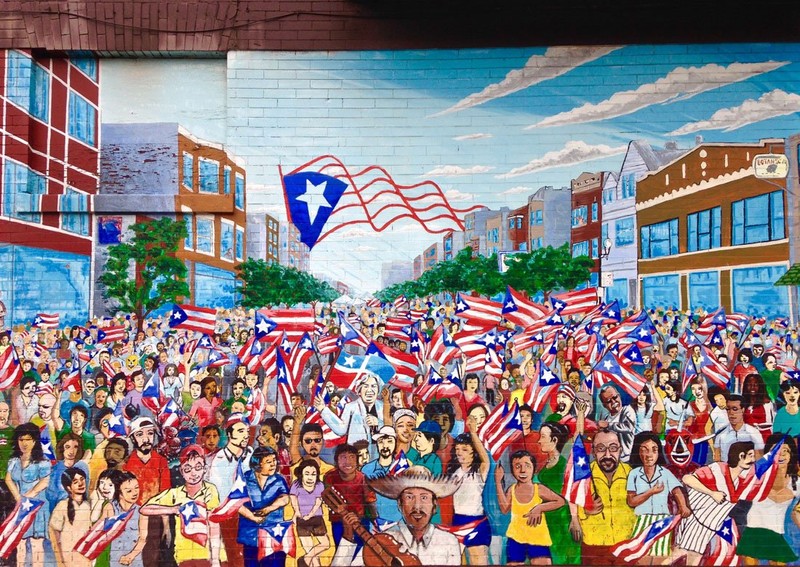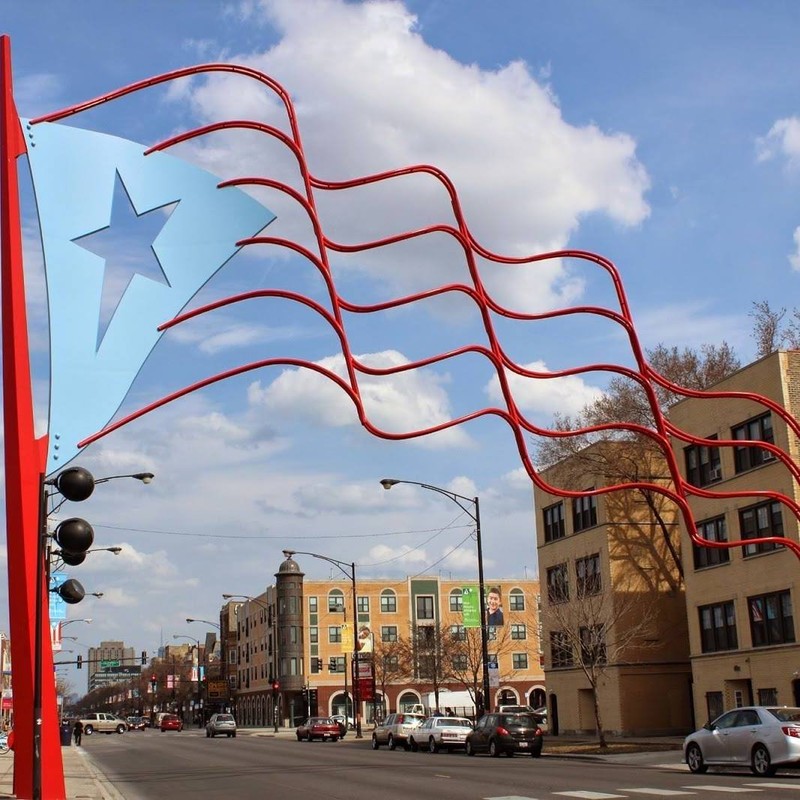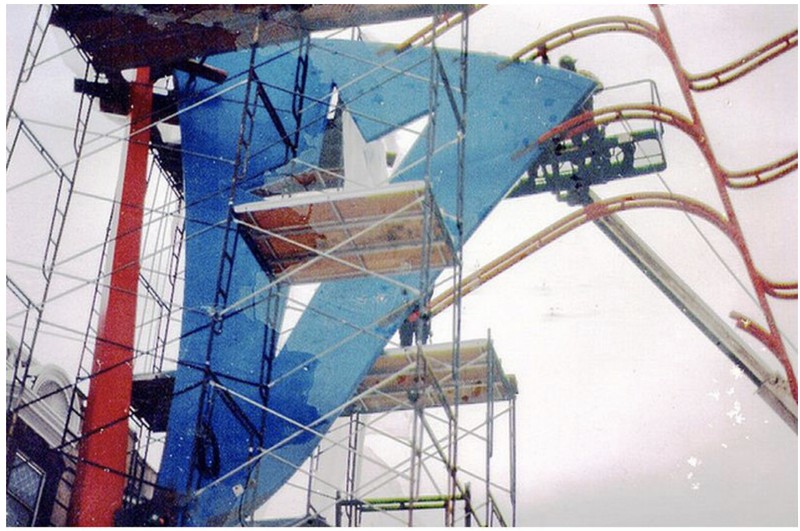Puerto Rican Flag Arches
Introduction
Text-to-speech Audio
Images
Mural “Sea of Flags" on Division Street by Gamaliel Ramirez

Photograph of the Puerto Rican Flag Arch by Humboldt Park Forever

Construction of the flag arches in the winter of 1994-1995

Backstory and Context
Text-to-speech Audio
In an effort to honor the Puerto Rican presence in the community and to respond to the community’s concern about work and housing discrimination, former Alderman Billy Ocasio began the project to install the steel flag arches on Division Street in 1994. Under the supervision of Chicago’s Department of Transportation and with the support of Congressman Luis Gutierrez and Mayor Richard M. Daley, architect Edward Windhorst from DeStefano + Partners was hired to design the installation. They were built by Chicago Ornamental Iron in Melrose Park. The flags were designed and created from steel to honor the hard work of generations of Puerto Ricans in the steel mills during the 1940s to 1960s. Completed in only five months, there was a formal dedication on January 6th, 1995 on “El Día de Los Reyes Magos” (Three Kings Day). The Puerto Rican Flag Arches solidified Humboldt Park as a Puerto Rican community and are the gateway into Paseo Boricua.
Paseo Boricua is not only home to the Puerto Rican Flag Arches, but it is also home to many Puerto Rican restaurants, stores, and sites. The installation of the flag arches led to opening of many new businesses on Division Street. La Casita de Don Pedro and the National Museum of Puerto Rican Arts and Culture are known gathering places for the community. Opened in 1997 and finalized in 1998, La Casita offers a gallery to showcase art from Puerto Rican artists and a garden. During the summer, La Casita becomes an artisan market where local artists can sell their work. The National Museum of Puerto Rican Arts and Culture (NMPRAC) is the only national museum that is centered on Puerto Rican arts and culture. Founded in 2000, the NMPRAC is committed to the community by offering arts and crafting workshops for students. The NMPRAC also partners with Chicago Public Schools whose arts programming is lacking or non-existent to offer an arts education program. La Casita de Don Pedro and the National Museum of Puerto Rican Arts and Culture are just a few of many things to do on Division Street while visiting the flag arches.
Puerto Ricans first migrated to Chicago not from the island but from New York. The first Puerto Ricans arrived in Chicago during the 1930s and 1940s. The migration of Puerto Ricans into the United States was a result of “Operación Manos a la Obra” (Operation Bootstrap) which led to working-class families to leave their home. Many of the Puerto Rican men in Chicago found jobs working in factories and steel mills while women typically worked as “domésticas”. When Puerto Ricans first moved into Chicago, they settled in South Clark and State Streets in the Loop. However, during the 1960s, Puerto Ricans were displaced to the northwest side of Chicago in Humboldt Park. The displacement to Humboldt Park was a result of ‘urban redevelopment’.
As Puerto Ricans began to settle into Humboldt Park during the 1960s, this period is also remembered for the 1966 riots known as the Division Street Riots. During the first Puerto Rican Day Parade on June 12th, 1966, an altercation between Chicago police and the community resulted in the fatal shooting of a Puerto Rican man. The outrage from the unjust murder of this man at the hands of the police resulted in three days of rioting. While these riots were a result of police brutality, activist were also fighting for fair housing and education. The Division Street Riots sparked numerous civil rights organizations created to fight for Puerto Rican’s rights, such as the Young Lords.
The proud flag
arches are a reminder of the vibrant Puerto Rican community firmly rooted in
Humboldt Park. Humboldt Park is also the location for the Puerto Rican Day
Festival and Parade every year. The parade begins on Division Street near the Puerto
Rican Flag Arches. This event allows Puerto Ricans to celebrate their people,
culture, and history in the neighborhood. Also, there are preservationists attempting
to immortalize the flag arches and their history. They are organizing for the Puerto
Rican Flag Arches to be recognized as an official Chicago landmark.
Additionally, in an effort to preserve the Puerto Rican culture in Humboldt
Park, Alderman Roberto Maldonado of the 26th ward brought forth a
resolution for the extension and renaming of the neighborhood to “Puerto Rico
Town”. Though the arches honor the history of Puerto Rican’s in Chicago, the
goal of this resolution is to demonstrate the extent of the Puerto Rican
community in this area that reaches beyond the flag arches.
Sources
1. Belaval, Ana. Steel, Strong and Storied: The Humboldt Park Puerto Rican Flags. WGN TV. September 29, 2016. . wgntv.com/2016/09/29/steel-strong-and-storied-the-humboldt-park-puerto-rican-flags/.
2. Newman, M.W.. Urban Gateway. Chicago Tribune. June 04, 1995. . www.chicagotribune.com/news/ct-xpm-1995-06-04-9506060354-story.html.
3. Toro-Morn, Maura. "De Bandera a Bandera (From Flag to Flag): New Scholarship about the Puerto Rican Diaspora in Chicago." Centro Journal, vol. 28, no. 2, 4-35. Published 2016.
4. Pérez, Gina. "An upbeat west side story: Puerto Ricans and postwar racial politics in Chicago." Centro Journal, vol. 13, no. 2, 47-71. Published 2001.
5. The National Museum of Puerto Rican Arts and Culture. . . https://nmprac.org/.
6. La Casita de Don Pedro y Doña Lolita. The Puerto Rican Cultural Center. . . https://prcc-chgo.org/arts-culture/la-casita-de-don-pedro/.
7. Bloom, Mina. Humboldt Park Stretch Renamed ‘Puerto Rico Town’ In Effort To Preserve Area’s Culture. Block Club Chicago. January 03, 2019. . https://blockclubchicago.org/2019/01/03/humboldt-park-stretch-renamed-puerto-rico-town-in-effort-to-preserve-areas-culture/.
